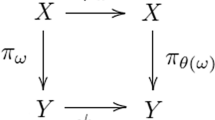Abstract
A family of random diffeomorphisms on a manifoldM is said to be a random dynamical system or RDS if it has the so-called cocycle property. The multiplicative ergodic theorem assignsd (=dimM) Lyapunov exponents to every invariant measure of the system. Take the maximum of the leading exponents associated with the various invariant measures. The resulting number is said to be the maximal exponent of the system. The minimal exponent is defined in a similar fashion. It is shown that the minimal exponent of an RDSϕ on a compact manifold is negative, provided not all invariant measures are determined by the future ofϕ. A similar statement relates the maximal exponent with the past ofϕ. We proceed by introducing Markov systems and Markov measures. This notion covers flows of stochastic differential equations as well as products of random diffeomorphisms in Markovian dependence, in particular, products of iid diffeomorphisms. Markov measures are characterized by the fact that they are functionals of the past. Consequently, if there exists a non-Markovian invariant measure, then the maximal exponent does not vanish. Typically, Markov systems do have non-Markovian invariant measures. Finally, for linear systems we recover results of Ledrappier. In particular, these results provide another proof of Furstenberg's theorem on the positivity of the leading exponent of a product of iid unimodular matrices.
Similar content being viewed by others
References
Arnold, L., and Kliemann, W. (1983). Qualitative theory of stochastic systems. In Bharucha-Reid, A. T. (ed.),Probabilistic Analysis and Related Topics, Vol. 3, Academic Press, New York.
Arnold, L., and Wihstutz, V. (eds.) (1986).Lyapunov Exponents, Proceedings, Bremen 1984, Lecture Notes in Mathematics 1186, Springer, Berlin.
Arnold, V. I., and Avez, A. (1967).Problèmes Ergodiques de la Mécanique Classique, Gauthier-Villars, Paris.
Baxendale, P. H. (1989). Lyapunov exponents and relative entropy for a stochastic flow of diffeomorphisms.Prob. Theor. Rel. Fields 81, 522–554.
Bougerol, P. (1988). Comparaison des exposants de Lyapunov des processus markoviens multiplicatifs.Ann. Inst. Henri Poincaré 24, 439–89.
Bowen, R. (1971). Entropy for group endomorphisms and homogeneous spaces.Trans. Am. Soc. 153, 401–414; Erratum.Trans. Am. Soc. 181, 509–510.
Carverhill, A. (1985). Flows of stochastic dynamical systems: Ergodic theory.Stochastics 14, 273–317.
Crauel H. (1986). Lyapunov exponents and invariant measures of stochastic systems on manifolds. In Arnold, L., and Wihstutz, V. (eds.),Lecture Notes in Mathematics 1186, Springer, Berlin, pp. 271–291.
Crauel, H. (1987).Random Dynamical Systems: Positivity of Lyapunov Exponents, and Markov Systems, Dissertation, UniversitÄt Bremen, Bremen. (Also Report No. 175, Institut für Dynamische Systeme, UniversitÄt Bremen, Bremen, 1988).
Crauel, H. (1989). Markov measures for random dynamical systems. Preprint, Bremen.
Dahlke, S. (1989).Invariante Mannigfaltigkeiten für Produkte zufÄlliger Diffeomorphismen, Dissertation, UniversitÄt Bremen, Bremen.
Dunford, N., and Schwartz, J. T. (1958).Linear Operators, Part I, Interscience, New York.
Furstenberg, H. (1963). Noncommuting random products.Trans. Am. Soc. 108, 377–428.
Guivarc'h, Y. (1984). Exposants caractéristiques des produits de matrices aléatoires en dépendence markovienne. In Heyer, H. (ed.),Probability Measures on Groups VII, Proceedings Oberwolfach 1983, Lecture Notes in Mathematics 1064, Springer, Berlin.
Hirsch, M. W. (1976).Differential Topology, Springer, New York.
Kullback, S. (1968).Information Theory and Statistics, Dover, New York (first published by Wiley, New York, 1959).
Kunita, H. (1982). On backward stochastic differential equations.Stochastics 6, 293–313.
Kunita, H. (1984). Stochastic differential equations and stochastic flow of diffeomorphisms. In Henequin, P. L. (ed.),école d'été de Probabilités de Saint Flour XII—1982, Lecture Notes in Mathematics 1097, Springer, Berlin.
Ledrappier, F. (1986). Positivity of the exponent for stationary sequences of matrices. In Arnold, L., and Wihstutz, V. (eds.),Lecture Notes in Mathematics dy1186, Springer, Berlin, pp. 56–73.
Ledrappier, F., and Young, L.-S. (1985). The metric entropy of diffeomorphisms I.Ann. Math. 122, 509–539.
Ledrappier, F., and Young, L.-S. (1988). Entropy formula for random transformatons.Prob. Theor. Rel. Fields 80, 217–240.
Le Jan, Y. (1987). équilibre statistique pour les produits de difféomorphismes aléatoires indépendants.Ann. Inst. Henri Poincaré 23, 111–120.
Oseledec, V. I. (1968). A multiplicative ergodic theorem. Lyapunov characteristic numbers for dynamical systems.Trans. Moscow Math. Soc. 19, 197–231.
Royer, G. (1981). Croissance exponentielle de produits markoviens de matrices aléatoires.Ann. Inst. Henri Poincaré Sect. B (N.S.) 16(1), 49–62.
Rozanov, Yu. A. (1967).Stationary Random Processes, Holden-Day, San Francisco.
Ruelle, D. (1979). Ergodic theory of differentiable dynamical systems.Publ. Math. IHES 50, 27–58.
Rudin, W. (1974).Real and Complex Analysis, McGraw-Hill, New York.
Virtser, A. D. (1979). On products of random matrices and operators.Theory Prob. Appl. 26(2), 367–377.
Walters, P. (1982).An Introduction to Ergodic Theory, Springer, New York.
Williams, D. (1979).Diffusions, Markov Processes, and Martingales, Wiley, Chichester.
Young, L.-S. (1986). Stochastic stability of hyperbolic attractors.Ergod. Theor. Dynam. Syst. 6, 311–319.
Author information
Authors and Affiliations
Rights and permissions
About this article
Cite this article
Crauel, H. Extremal exponents of random dynamical systems do not vanish. J Dyn Diff Equat 2, 245–291 (1990). https://doi.org/10.1007/BF01048947
Issue Date:
DOI: https://doi.org/10.1007/BF01048947



